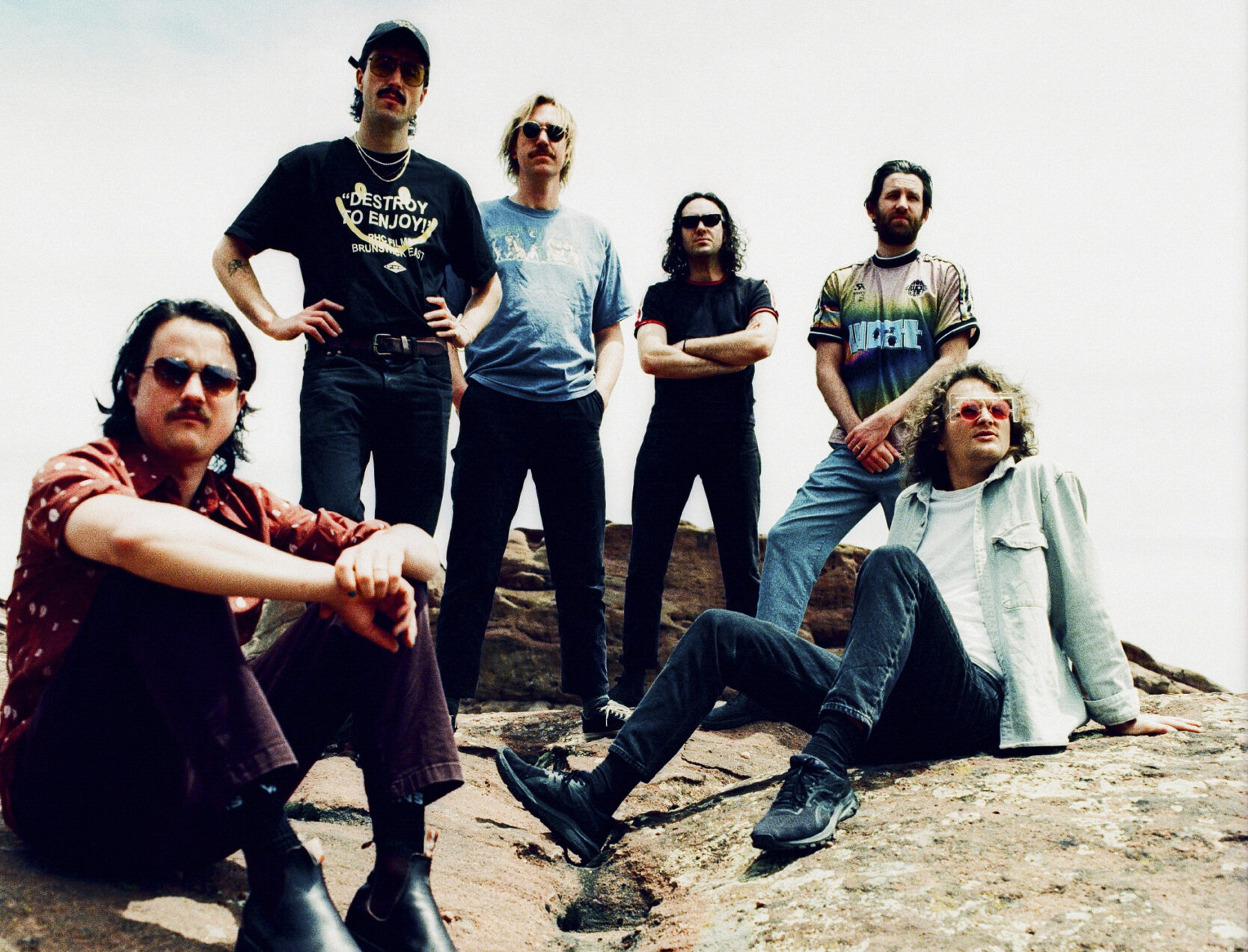In the past three-plus years, Australia’s King Gizzard and the Lizard Wizard has self-released nine studio albums and more than a dozen live, remix, and demo collections, grown its audience by a factor of at least 10, jumping from clubs and theaters to packed shows in historic venues such as New York’s Forest Hills Tennis Stadium and Los Angeles’ Hollywood Bowl, and somehow managed to find time to function as, you know, actual human beings with spouses, girlfriends, children, and lives not 102% devoted to the all-consuming art of music-making.
For many bands, creating that art can often feel more like work than pleasure. For King Gizzard, comprised of multi-instrumentalists Stu Mackenzie, Joey Walker, Ambrose Kenny-Smith, and Cook Craig, bassist Lucas Harwood, and drummer Michael “Cavs” Cavanagh, it’s nothing but fun and adventure. But where does a band in this privileged position go from there? Play the same hits every summer on the festival circuit? Make big bucks writing tracks for pop stars? No, that would be far too easy, and King Gizzard doesn’t do easy. Instead, its six members have pushed their maximalist aesthetic to a level simply unequaled by any of their contemporaries and now stand largely alone at the vanguard of forward-thinking modern music. After all, if you can’t challenge yourself to do something nobody else has done before, why bother in the first place?
“The maximalist aspect is probably just tied into our personalities and who we are,” chuckles Mackenzie over the phone from his home outside Melbourne. “King Gizzard definitely has a maximalist energy, generally. There isn’t a lot of subtlety. That’s not our strong point. From time to time, we’ll probably exercise it a little bit, but I don’t think that’s our resting place.”
With the June release PetroDragonic Apocalypse or Dawn of Eternal Night: An Annihilation of Planet Earth and the Beginning of Merciless Damnation and The Silver Cord, due Friday, King Gizzard has created two distinct but related albums out of an idiosyncratically specific conceptual framework — both are seven tracks long, with each song in the running order sharing musical and/or lyrical elements with its corresponding song on the other project. In both cases, each album’s names, song titles, and lyrics were written before a note of music was recorded, giving them time to seep into the band’s collective unconscious long before it turned on the amps.
And while PetroDragonic is 48 breathless minutes of thrash, prog, and metal soundtracking a linear tale of planetary destruction at the hand of an unstoppable dragon, The Silver Cord is a more nuanced reflection on the circle of life, its 88 minutes bursting at the seams with a studio’s worth of synthesizers and a litany of references to ancient gods and goddesses. “We were thinking about the soul and the spirit and existentialism and why we’re here, birth and death, and rebirth and spirituality,” Mackenzie says. King Gizzard has also edited those “extended mixes” into a more digestible 28-minute edition of The Silver Cord, in effect serving as its own remixers in the grand traditions of dance music pioneers such as Giorgio Moroder and Arthur Baker (for reference, opener “Theia” is 20:42 on the long version and 3:24 on the edit).

For fans more partial to Gizzard’s usual guitar-based rock’n’roll creations, The Silver Cord will be a dizzying listen, and one during which you’ll discover something new every time. One minute you feel like you’re on ecstasy in the Coachella dance tent (“Set” approximates the Cheshire cat-grinning, rhythmic syncopation of late ‘90s Underworld, with rapping by Kenny-Smith) or a slam-dancing in an underground leather bar (“Gilgamesh” conjures vein-bulging industrial dance/rock a la Nine Inch Nails). The next, you’re floating downstream with your stomach rumbling (“Extinction” is dominated by austere three-note trills that would have terrified Middle Ages aesthetes if played on a church pipe organ) or descending through the alien landscapes of a distant planet (the title track alternates between disturbing electronic vocalizations and moments of Autotuned, major-key beauty).
There are nods to the “hoot hoot” funhouse mirrors and fast-approaching freight train whistles of Kraftwerk, the smooth, synthetic soundscapes of Air, the hyperactive side of Daft Punk circa the TRON: Legacy soundtrack, LTJ Bukem/DJ Hype-style drum and bass, jungle, trance, and Detroit techno. Devotees will also have a field day identifying common elements shared between Petro and The Silver Cord — the same riffs and melodies turn up in multiple songs, albeit in totally unique musical circumstances, and turns of phrase about witchcraft, Gila monsters, and flamethrowers are woven throughout both albums.
Those with especially astute ears will be able to derive the origin of other shared musical tidbits as Gizzard’s increasingly jam-oriented live shows — for example, the key “Extinction” lyric “I can see everything I can be in the music” was sung on stage by Kenny-Smith as recently as three months ago. The stories of the albums themselves are now even more open to interpretation when viewed as companions, a notion Walker describes as Gizzard’s “main M.O: be didactic about what we want to get across, but leave it open for the fans to create their own lore surrounding what it’s all about. That’s really fun, and it’s definitely an intention of ours.”
It wasn’t clear from the beginning that The Silver Cord would be released in long and short forms, but that approach allowed the band to indulge its love of going to many places at once. In typical Gizzard fashion, there are also some musical surprises hidden on the vinyl version of the short Silver Cord, if you know where to look. “When we were recording, we weren’t thinking too much about arrangement,” Mackenzie says. “We were looking for what we call endless boogies — when you’re in the pocket and it feels like whatever you’re doing could go forever, like Can or Neu!. We were in there for hours on end just trying to find those pockets and exist in them. Within those endless boogies, we found nuggets that felt like quote-unquote songs, or what normal people think of as songs — not people like us who are happy for a song to just be 20 minutes of ambience.”
“Making two versions was incredibly liberating and freeing,” he continues. “It’s really tied up into the DNA of what the record is, because instead of making one decision for a song, we could make a bunch of decisions and find places for them. It always hurts to mutilate your song, but this time, we could kind of clone it and let it go in two different directions at once, which felt really fun. Maybe we’ll do this again one day.”
It’s all even more impressive given the band members’ admitted lack of skill on electronic instruments, which they’d really only featured once before when assembling the 2021 synth album Butterfly 3000 remotely during COVID-19 travel restrictions.
“At that point, Butterfly was the most electronic record that we’d made,” says Mackenzie, who is partial to the Juno 60 the band bought while making the 2014 album Oddments. “But it was a nightmare trying to figure out how to play it, because it was pieced together part by part during the pandemic. Lately, our shows have become more improvised and loose. We’re listening to each other more, which makes it like spontaneous creation, but that’s with drums and guitars. We thought, how do we do that with electronic instruments? How do we birth two albums from the same world and then let them grow into their own shapes and personalities?”
The answer, as with Petro and guitars, was for band members to plug in every possible piece of synth-related gear they could find in their studio, press “record,” and lock in on the ensuing mayhem. Mackenzie recalls, “We did spend several days making very shit music. There were definitely times when I thought, I don’t think this is gonna work. This is just not very good (laughs).” The vibe changed once band members realized they were inhabiting the same dynamic ranges they do on stage, even though they were playing completely different gear.
“Lukey did still play the bass synth on this whole album, so he was still occupying his usual spot,” Mackenzie says. “Same with Cavs, even though he was playing an electronic drum kit. Joe and I are doing most of the top-line melodic stuff, and we’re harmonizing with each other a lot. Cookie and Amby are very much filling in the body of the song. We’re not doing crazy scales or moving our fingers real fast along the keyboard or anything. There’s no virtuosic playing here. If there is a skill in it, it’s things we’ve learned playing other instruments. We still are in our regular little niches, which made it feel like we knew what we were doing.”
What’s more, Mackenzie says the recorded-live aspect of The Silver Cord could lead to its material one day making it into the Gizzard concert repertoire, in contrast with the songs on Butterfly, only one of which (“Shanghai”) has ever been performed.
“I do think that we will find a way to play a lot of this material,” he says, acknowledging uneven attempts to incorporate a synth workstation into Gizzard’s summer 2023 shows. “Once we crack the nut on one of these songs, it’s possible we’ll crack the nut on all seven of them simultaneously. When we tried to figure out how to play the Butterfly songs and rehearse them as a band, we were instantly demoralized and it’s been very hard to go back there and pick it up. That was the seed to do something that just felt more straightforward in that particular sense, and more like a band. We’re a fucking band — let’s play like a band.”

If anything, Petro and The Silver Cord (the band’s 24th and 25th studio albums since its 2010 formation) reinforce what has become a kaleidoscope Gizzard listening experience — there’s truly something for everyone not only within the discography but also at a concert. “If you’re coming to a Gizz show, you probably wouldn’t have only listened to one of our albums,” Cavanagh says with a laugh. “You would have listened to at least two, and they’re all different. I always think about the people who didn’t want whatever we’ve just put out, but that’s what they got. It’s Gizz, so you’ve just got to prepare yourself for anything.”
It’s an idea the members of King Gizzard deal with on a daily basis, even though their lives are now being planned out some 18 months in advance. Although it was in the studio recording new music every day for a week earlier this month, the band is presently on a rare extended break from touring, which will last until next spring. Its summer 2024 itinerary includes another round of marathon three-hour shows at such locales as Forest Hills, the already sold-out 9,200-capacity Huntington Bank Pavilion outside Chicago, and the 21,600-capacity Gorge Amphitheater outside Seattle, the largest venue it has ever played in North America.
“I can’t just, like, put everything down. It’s not the way my brain is wired,” says Mackenzie, who is expecting his second child any day now. “If I stop making music, I start frantically doing some other non-productive activity (laughs). We’ve got a few projects on the go — not anywhere near completion or anything, but a couple of spinning plates.”
Mackenzie confirms it is “totally possible” King Gizzard will have a new album out by next summer, but even that hint of uncertainty feels unusual for him. “By the time it gets to October, I feel like I’ve got a very solid plan of how the releases are going to sit for the following year,” he reports. “As I’m here now thinking about next year, it’s just going to be what it’ll be. I’m saying that now. I might not be saying that tomorrow. Sometimes you’ve got to make your future and make your reality, and other times you’ve got to sit there cross-legged in Buddha pose and wait for the lightning to strike you. I think both methods in balance and harmony are valid.”
However it keeps happening, King Gizzard is actualizing even the zaniest ideas at an impossibly high level, and more and more fans keep jumping aboard the ride (if it’s any measure, the band’s robust Reddit feed has grown by 24,000 members alone in the past year). “From where I’m sitting, honestly, it all feels very abstract,” Mackenzie admits. “It’s insanely flattering and humbling and just freaky, but it sometimes feels like it’s happening to someone else and I’m just acting this part. Really, I’m extremely grateful, because we get energy from the whole thing. It’s like a beautiful spiral of positivity. As long as people are willing to come watch us play, I’m pretty sure we’re going to just keep playing.”





